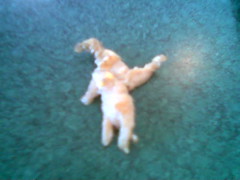On the evolutionary scale, I would have to say that rice and human beings, while obviously separated by intermediary species such as whales and bumble-bees, have a lot in common -- Chicken fried rice, rice-cakes, Rice-a-roni, to name a few.
 Image by Carey Tilden via Flickr
Image by Carey Tilden via FlickrMost humans probably look down their elegantly refined noses at rice. (In fact, some human beings who have just chowed down on the local Chinese all-you-can-eat lunch buffet probably have a grain or two of rice stuck on the end of their noses.)
But, they shouldn't. Did you know that in the evolutionary tooth-and-claw struggle for survival that the lowly grain of rice, lacking both tooth and claw, has managed to come up with more genes than us? I would say that's impressive. Remember Dawkins: the species with the most genes wins!
Dr Andrew George, reader in molecular immunology at the Hammersmith campus explained: Although humans are normally thought to be considerably more complex than organisms, such as plants, rice, yeast and earthworms, this is not reflected in their number of genes - humans have less [sic] than other supposedly less complex organisms. -- ICL ReporterNext time you throw rice at a wedding, remember this: you are throwing a highly evolved, highly complex life-form into the air. You might want to consider throwing your cousin George instead.
However, we get to eat rice, and no grain of rice has ever been known to fry-up and eat a human, so, I'm calling this a win for human beings!
PS -- I plan to do some further research today at the local Chinese lunch buffet. Will report back.
Related articles by Zemanta

6 comments:
Rice and humans are not separated by intermediary species; that is a complete mischaracterization of evolution. We do, however, share a common ancestor that likely died out more than a billion years ago. The only thing you got right is that wild rice is no less complex, no less well-adapted to its environment, than humans. It is older than us, more populous than us, more diversified than us, and as a result, the genus Oryza will quite likely out survive the genus Homo.
What I find funny in your attempts at humour is that no matter how ridiculous you try to make evolutionary science sound with your mischaracterizations, it pales in comparison to the ridiculousness found in the first three chapters of Genesis.
(ps., I think Dawkins would now argue that the genes with the most species win).
"Rice and humans are not separated by intermediary species; that is a complete mischaracterization of evolution."
Just like darwinism is a complete mischaracterization of the intelligent, information-rich purposeful process that resulted in humans.
So what you are saying P@J is that when life first came into existence in that primordial soup there was both plant and animal doohickies? Or did life begin as a generic form and then differentiate into the two forms we fawningly call flora and fauna? If the the latter then there would have to have been some sort of intermediate something or other although I suppose it may not rank as a species. But then again those evolutionists do have trouble with intermediary species don't they. It just seems they can't find any.
BTW do they deep fry rice??? Jonathan wanted to dip his hand in a fryer. With all due respect his comments reminded me of the pimply teenager on The Simpsons who repeatedly dipped his hand in the deep fryer in a failed attempt to retrieve a hamburger. Time and time again dipping and withdrawing his hand and with each withdrawal came a brainless monotone 'Ow'.
I’m assuming you are honestly uninformed and not being facetious. Poe’s law applies.
First off, life is not divided into “plant” and “animal”, there are whole categories that the author of Genesis seemed to miss in his description of the beginnings of life: Fungi, Protists, Monera. Actually, there are more types of Monera (Bacteria and Archaea) than all other life forms combined. Some photosynthesise like plants, some get their energy from oxidizing sugars, like animals. Others have completely different metabolic systems, like those that metabolise sulphur at deep sea vents or those that metabolise hydrocarbons. Some cannot live without oxygen, some expire instantly when exposed to oxygen. Examples of both types live in your gut. There are more individual Bacteria cells in and on your body than there are human cells in your body, by at least a factor of 10.
So your false dichotomy of plants vs. animals is just that: false. The common ancestor of plants and animals was probably something that we would now classify as single-cell eukaryote, if it were to still exist. And yes, it would have animal-like mitochondria and plant-like mitochondria, and other types we would not now recognize as either, presumably.
I’m not sure what you would term an “intermediary species”, as the idea seems to presume that two distantly-related living species (crocodile and duck) would be found to have a single animal right in between them, known as the “croco-duck” fallacy. In reality, the last common ancestor of the crocodile and duck was probably a very early semi-aquatic reptile that lived in the Permian or earlier. If you mean to imply that “evolutionists” have a hard time finding common ancestors, then you are simply wrong. Transitional species are abundant, and more turn up every year.
Always wanted to see one of them intermediary critters that thrived on oxygen yet found oxygen to be deadly poison.
Post a Comment